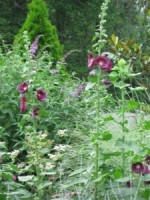 There are few plants that create old-fashioned charm better than hollyhocks. I don’t have a wall or picket fence to set them off but they still bring the suggestion of a cottage garden to my border. I love having them in the garden so buy seed to be sure than I have them every year, although they usually reseed themselves. The seeds are easy to germinate in cell packs and then transplant to the border in the fall where they quickly grow into large clumps of leaves, putting up their giant flower-bearing stalk as spring turns into summer. The stalk towers above most of the other plants in the border providing a strong vertical accent with about 18-24” of the stalk bears flowers at any given time. I have tried the double forms and they are beautiful but look more like carnations than hollyhock. Rust and Japanese beetles can be serious problems but I just include the hollyhocks in my weekly anti-fungus spray schedule and daily Japanese beetle pick to keep things under control. Sometimes the poor hollyhock get so ratty looking I cut them down before they are finished and they reward me with a new tuft of leaves (with no rust or beetles).
There are few plants that create old-fashioned charm better than hollyhocks. I don’t have a wall or picket fence to set them off but they still bring the suggestion of a cottage garden to my border. I love having them in the garden so buy seed to be sure than I have them every year, although they usually reseed themselves. The seeds are easy to germinate in cell packs and then transplant to the border in the fall where they quickly grow into large clumps of leaves, putting up their giant flower-bearing stalk as spring turns into summer. The stalk towers above most of the other plants in the border providing a strong vertical accent with about 18-24” of the stalk bears flowers at any given time. I have tried the double forms and they are beautiful but look more like carnations than hollyhock. Rust and Japanese beetles can be serious problems but I just include the hollyhocks in my weekly anti-fungus spray schedule and daily Japanese beetle pick to keep things under control. Sometimes the poor hollyhock get so ratty looking I cut them down before they are finished and they reward me with a new tuft of leaves (with no rust or beetles).
Type: Biennial/perennial.
Bloom: Large flowers in various shades of white, pink, red, yellow, maroon, borne on tall stalks in summer.
Size: 6-8’ H x 3’ W.
Light: Full sun; tolerates some shade.
Soil: Rich, moist, deep, well drained.
Hardiness: Zones 3-9.
Pests and Diseases: Rust, Japanese beetles, leaf spot, anthracnose and spider mites can be a problem.
Propagation: Seed (reseeds).
Companion plants: Globe thistle (Echinops ritro), Russian sage (Pervoskia atriplicifolia), white garden phlox (Phlox paniculata) like ‘David’, cosmos.
Outstanding Selections: ‘Chaters Double” mostly double flowered, on 6’ stems.
